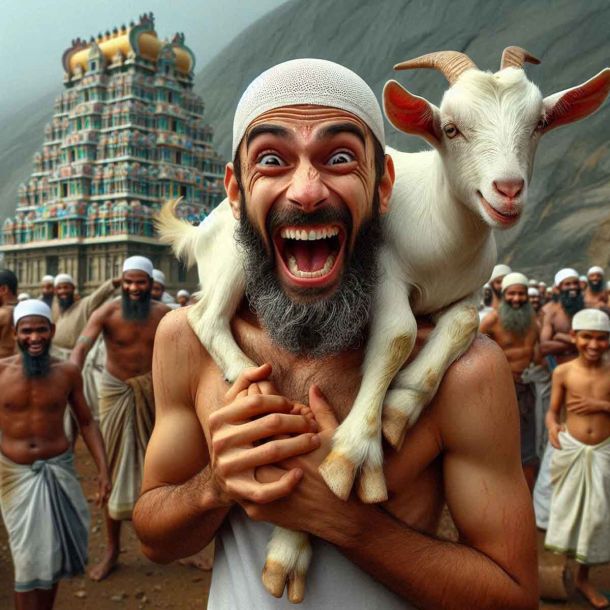More Coverage
Twitter Coverage
Satyaagrah
Written on
Satyaagrah
Written on
Satyaagrah
Written on
Satyaagrah
Written on
Satyaagrah
Written on
Join Satyaagrah Social Media
"धान्यानामुत्तमं दाक्ष्यं धनानामुत्तमं श्रुतम्। लाभानां श्रेय आरोग्यं सुखानां तुष्टिरुत्तमा": Sanatana is a comprehensive system of life, consisting of religion, spiritual philosophy and knowledge system, social and political setup and goal is of Moksha

Sanatana Dharma is a comprehensive system of life, consisting of religion, spiritual philosophy and knowledge system, and social and political setup.
Dharma: The Sanskrit word Dharma has no direct translation into English. Among other things, it can be thought of as righteousness in thought, word, and action. It comes from the root Dhr, which means to uphold, sustain, or uplift. Thus another interpretation of the word in English would be 'the collection of natural and universal laws that uphold, sustain, or uplift.' Ie. law of being; law of nature; individual nature; prescribed duty; social and personal duties; moral code; civil law; code of conduct; morality; a way of life; practice; observance; justice; righteousness; religion; religiosity; harmony.
|
The goal of Sanatana Dharma is Moksha, liberation. It aims at 'Mukti' for every individual, and all the methods it prescribes are towards that goal. Fulfillment of the purposes of life is the means to it. However, the phenomenal world is diverse, and hence there are diverse means to fulfilling the purpose of life.
Moksha: Breakage of the cycle - the cycle of mind, a cycle of time, a cycle of births, i.e., transcending existence. Moksha is referred to by many names. For example, it is also addressed as 'mukti' or freedom, and other terms for this state are apavarga, kaivalya, kalyana, nihsreyasa, nirvana, sayujya, and yoga-ksemma. A pursuer of Moksha is a Moksha-kami or Mumuksha
According to Sanatana dharma, each being is potentially divine. Realization is about unveiling the divinity. God, who created the universe, is not different from it - He exists unmanifest, but the entire creation is also a part of Him. He exists essentially, in each particle and phenomenon of creation.
Each being, through its cycles of birth and death, is evolving towards the same goal, according to Sanatana Dharma. So equality and inequality are apparent, and not essential. These differences are because of the diversity in methods, and differences in the stages and phases through which each being is going at any point in time.
Windows
However, there are multiple windows to Truth that describe the eternal, its relation to the universe, and the concept of liberation. These are called Darsanas. They are six and listed as Nyaya, Vaiseshika, Sankhya, Yoga, Purva Mimamsa and Uttara Mimamsa. They differ in whether there is a "creator-God" different from the eternal, what causes binding and what causes liberation etc, but they all have a common stand, e.g. there is an eternal spirit, indwelling presence (Purusha), who is actually liberated, but appears to be bound by the play of Nature (Prakriti). They are also common in that their goal is liberation. They all advocate righteousness and devotion as means to liberation, though they suggest different methods. They are also common in that they take Veda as the authority.
Purposes
There are four goals of life to fulfill which one should work - Dharma, Artha, Kama, and Moksha. That is Righteousness, generation of wealth/production, fulfillment of desires, and salvation. The first three are means to the last.
There are three paths to salvation. One is of devotion (bhakti) where an individual through devotion to God, attains moksha. This is prescribed for the heart being. Worship is his method; Devotion is the means; bliss and love are the goals.
The second is knowledge (jnana), where one sublimates his lower being through gaining knowledge. This is for the intellect-being. Study/thought is his method; Curiosity his means; Truth the goal.
The third is of works (karma), where one through the fulfillment of responsibilities as an individual and then serving fellow beings, attains moksha. This is for the social being. Service is his method; Selflessness his means; infinity and permanence the goal.
Thus truth-beauty-permanence, the three aspects of the eternal, are the goals of these three paths. They are intermixing and overlapping paths, with each of them leading to and merging with the others.
Scriptures
The root of Sanatana Dharma is the Veda. The Veda is said to be classified before the beginning of Kali Yuga (about 3100 BC according to the traditional version), by Vyasa, into four - Rig, Yajus, Sama, and Atharva. Each Veda has three portions, Samhita (hymns to gods), Brahmana (ritual portion), and Aranyaka (philosophy portion).
There are two major streams of literature, which developed from the Veda and base their authority on it. One of them is the smriti literature, where the entire literature is classified into 18 abodes or mahasthanas. They are the four Vedas, six Vedangas (sastras to understand the Veda, literally the parts of Veda), four Upangas (consisting of dharma viz codes of conduct, etc logic), and four Upavedas (arts and sciences). Then there are six darsanas or windows to the truth. The second stream is the Agama literature, consisting of Mantra, Yantra, and Tantra.
However these are not mutually exclusive streams, and there are many aspects like underlying spiritual philosophy, mantras, and some procedures for rituals that are common.
Scope and Definition
What classifies one as belonging to or outside the fold of Sanatana Dharma, is not as straightforward as answering what classifies one as belonging to or outside the fold of any particular community.
Sanatana Dharma, as it implies, is the eternal law - hence anyone by definition is included in it. It does not classify people as followers and non-followers, believers and non-believers, and so on. Thus by definition, it is universal and all-inclusive. This is because it talks of the natural and universal order or law, and not of the universe as seen by any particular seer.
However, when seen in a social context there do exist many classifications. The people belonging to the civilization of Bharata share a common cultural and social base; they differ in philosophy and few social aspects. The first such division is Vedic-Unvedic.
Accepting the authority of Veda is the primary criterion, for defining a person as belonging to Veda mata. And this covers all the branches, such as srauta, smarta, Tantric, and so on. However, there are further classifications in this: There are schools that hold Atharva vedins as unvedic. There are schools that hold some Tantras as unvedic. And so on. However, with all the philosophical and religious differences, they all share one cultural-social base.
The schools that do not hold Veda as a primary authority are called Unvedic. Bauddha and Jaina, though they believe in salvation (having their own versions of Nirvana and Kaivalya respectively) are thus called Unvedic. They do not however call the Veda false knowledge. Bauddha and Jaina also share the same civilizational and philosophical base and world view as Vedic religion. Hence they are very much parts of the Bharatiya Civilization.
However, this should not be understood in the sense that Veda is to be taken as an "authority". Veda is taken as a Pramana or a source and reference for the validation of knowledge. And a school that does not accept Veda as pramana, implies that it does not believe in statements other than those that could be validated through other means of knowledge.
Thus the Vedic-unvedic became a slightly different classification, Astika - Nastika. There are two criteria that make one an Astika or having astikya: believing in Veda's pramanya, and following varna-ashrama dharma. The belief in Veda translating as Astikya borrows sense from the above explanation, of "something that cannot be validated can exist and still be accepted as true".
Accepting God or Iswara has never been a criterion in classifying something as Astika or Vedic or Hindu for that matter. Owing to the differences in approach and diversity in world views, accepting the existence of God has always been a matter of choice and one's philosophy. Diversity in the attribution of supremacy to God, religious practices, and philosophical traits, none of these matter in classifying something as Vedic-Unvedic.
Spirit of Sastras
Sastra is a study of the phenomena of the universe through specific means for a specific purpose.
The word sastra is representative of both art and science forms. Some sastras are sciences, while some are art forms. However the art forms, too, are called sastras, both because their origin is based on sastra and because their pursuit is a well-laid path. There is no clear line between art and science. In fact, as has been said, the pursuit of science is an art and the pursuit of art is a science. Independent of the subject, the pursuit of science and art involves creativity. Though there are differences in the acceptable methods and approaches in each sastra, and though there are differences in the states and levels of consciousness that validate truth, both science and art aim at Truth.
Sabda
Sabda (sound) is a concept where we can clearly observe the evolution of various sastras from one base. Sabda is the tanmatra of akasa (the sky). In the five elements, Akasa represents brahman. Thus Sabda is eternal. The study of the eternal word is mantra sastra. Mantra is a word. It has multiple aspects, and the study of each aspect evolved as a sastra. The two aspects of the word are - sabda (sound form) and pada (verbal form). The former has two aspects, dhvani (sound) and swara (tone). The latter has four aspects, akshara (alphabet, syllables, and their arrangement), artha (meaning semantics), vyakarana (syntax, order, and arrangement of words) and chandas (arrangement of syllables). Each of these aspects is a sastra. The sound-energy root is beeja. Its study is a mantra. Swara has two aspects again, their study being Siksha (phonetics) and Nada (Sangeeta-music). The word aspect is another study. It involves the alphabet. Arrangement of alphabet/syllables is Chandas. The arrangement of the alphabet into words and the study of the meaning of words is Nirukta. The grammar of the language formed with words is Vyakarana.
Individual and Social Life
There are a set of institutions that drive individual and social life in Sanatana Dharma. They are:
Dharma: the determinant of righteousness or right action
Ashrama: four stages of life through which an individual attains fulfillment and serves goals of life
Vivaha Vyavastha: marriage, the basic building block of society
Varna: an abstraction based on various functions performed by men in society.
Jati: an autonomous endogamous cultural unit
References:
hindupedia.com
 Support Us
Support Us
Satyagraha was born from the heart of our land, with an undying aim to unveil the true essence of Bharat. It seeks to illuminate the hidden tales of our valiant freedom fighters and the rich chronicles that haven't yet sung their complete melody in the mainstream.
While platforms like NDTV and 'The Wire' effortlessly garner funds under the banner of safeguarding democracy, we at Satyagraha walk a different path. Our strength and resonance come from you. In this journey to weave a stronger Bharat, every little contribution amplifies our voice. Let's come together, contribute as you can, and champion the true spirit of our nation.
 |  |  |
| ICICI Bank of Satyaagrah | Razorpay Bank of Satyaagrah | PayPal Bank of Satyaagrah - For International Payments |
If all above doesn't work, then try the LINK below:
Please share the article on other platforms
DISCLAIMER: The author is solely responsible for the views expressed in this article. The author carries the responsibility for citing and/or licensing of images utilized within the text. The website also frequently uses non-commercial images for representational purposes only in line with the article. We are not responsible for the authenticity of such images. If some images have a copyright issue, we request the person/entity to contact us at This email address is being protected from spambots. You need JavaScript enabled to view it. and we will take the necessary actions to resolve the issue.
























